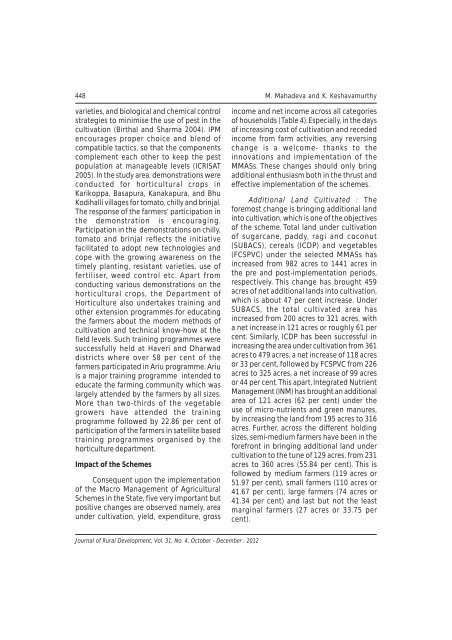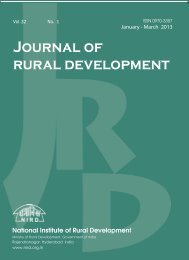October - December 2012 - National Institute of Rural Development
October - December 2012 - National Institute of Rural Development
October - December 2012 - National Institute of Rural Development
- No tags were found...
You also want an ePaper? Increase the reach of your titles
YUMPU automatically turns print PDFs into web optimized ePapers that Google loves.
448 M. Mahadeva and K. Keshavamurthyvarieties, and biological and chemical controlstrategies to minimise the use <strong>of</strong> pest in thecultivation (Birthal and Sharma 2004). IPMencourages proper choice and blend <strong>of</strong>compatible tactics, so that the componentscomplement each other to keep the pestpopulation at manageable levels (ICRISAT2005). In the study area, demonstrations wereconducted for horticultural crops inKarikoppa, Basapura, Kanakapura, and BhuKodihalli villages for tomato, chilly and brinjal.The response <strong>of</strong> the farmers' participation inthe demonstration is encouraging.Participation in the demonstrations on chilly,tomato and brinjal reflects the initiativefacilitated to adopt new technologies andcope with the growing awareness on thetimely planting, resistant varieties, use <strong>of</strong>fertiliser, weed control etc. Apart fromconducting various demonstrations on thehorticultural crops, the Department <strong>of</strong>Horticulture also undertakes training andother extension programmes for educatingthe farmers about the modern methods <strong>of</strong>cultivation and technical know-how at thefield levels. Such training programmes weresuccessfully held at Haveri and Dharwaddistricts where over 58 per cent <strong>of</strong> thefarmers participated in Ariu programme. Ariuis a major training programme intended toeducate the farming community which waslargely attended by the farmers by all sizes.More than two-thirds <strong>of</strong> the vegetablegrowers have attended the trainingprogramme followed by 22.86 per cent <strong>of</strong>participation <strong>of</strong> the farmers in satellite basedtraining programmes organised by thehorticulture department.Impact <strong>of</strong> the SchemesConsequent upon the implementation<strong>of</strong> the Macro Management <strong>of</strong> AgriculturalSchemes in the State, five very important butpositive changes are observed namely, areaunder cultivation, yield, expenditure, grossincome and net income across all categories<strong>of</strong> households (Table 4). Especially, in the days<strong>of</strong> increasing cost <strong>of</strong> cultivation and recededincome from farm activities, any reversingchange is a welcome- thanks to theinnovations and implementation <strong>of</strong> theMMASs. These changes should only bringadditional enthusiasm both in the thrust andeffective implementation <strong>of</strong> the schemes.Additional Land Cultivated : Theforemost change is bringing additional landinto cultivation, which is one <strong>of</strong> the objectives<strong>of</strong> the scheme. Total land under cultivation<strong>of</strong> sugarcane, paddy, ragi and coconut(SUBACS), cereals (ICDP) and vegetables(FCSPVC) under the selected MMASs hasincreased from 982 acres to 1441 acres inthe pre and post-implementation periods,respectively. This change has brought 459acres <strong>of</strong> net additional lands into cultivation,which is about 47 per cent increase. UnderSUBACS, the total cultivated area hasincreased from 200 acres to 321 acres, witha net increase in 121 acres or roughly 61 percent. Similarly, ICDP has been successful inincreasing the area under cultivation from 361acres to 479 acres, a net increase <strong>of</strong> 118 acresor 33 per cent, followed by FCSPVC from 226acres to 325 acres, a net increase <strong>of</strong> 99 acresor 44 per cent. This apart, Integrated NutrientManagement (INM) has brought an additionalarea <strong>of</strong> 121 acres (62 per cent) under theuse <strong>of</strong> micro-nutrients and green manures,by increasing the land from 195 acres to 316acres. Further, across the different holdingsizes, semi-medium farmers have been in theforefront in bringing additional land undercultivation to the tune <strong>of</strong> 129 acres, from 231acres to 360 acres (55.84 per cent). This isfollowed by medium farmers (119 acres or51.97 per cent), small farmers (110 acres or41.67 per cent), large farmers (74 acres or41.34 per cent) and last but not the leastmarginal farmers (27 acres or 33.75 percent).Journal <strong>of</strong> <strong>Rural</strong> <strong>Development</strong>, Vol. 31, No. 4, <strong>October</strong> - <strong>December</strong> : <strong>2012</strong>

















